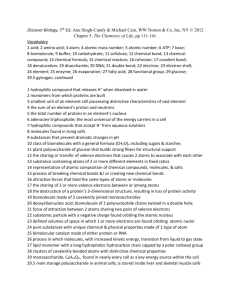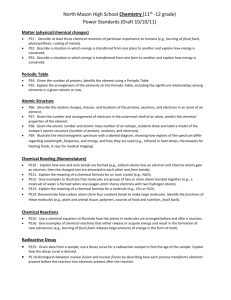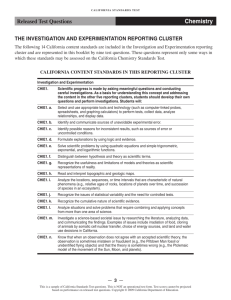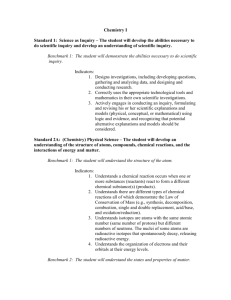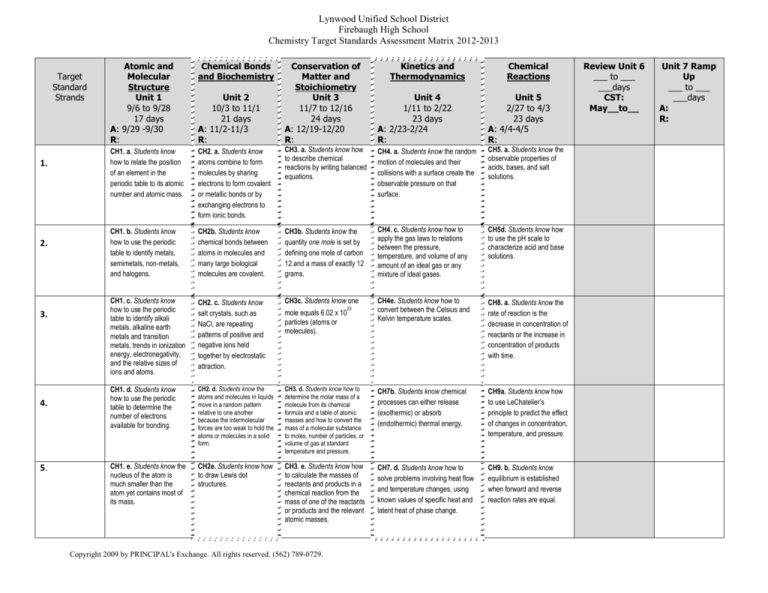
Lynwood Unified School District
Firebaugh High School
Chemistry Target Standards Assessment Matrix 2012-2013
Target
Standard
Strands
1.
2.
3.
4.
5.
Atomic and
Molecular
Structure
Unit 1
9/6 to 9/28
17 days
A: 9/29 -9/30
R:
Chemical Bonds
and Biochemistry
Unit 2
10/3 to 11/1
21 days
A: 11/2-11/3
R:
Conservation of
Matter and
Stoichiometry
Unit 3
11/7 to 12/16
24 days
A: 12/19-12/20
R:
Kinetics and
Thermodynamics
Chemical
Reactions
Unit 4
1/11 to 2/22
23 days
A: 2/23-2/24
R:
Unit 5
2/27 to 4/3
23 days
A: 4/4-4/5
R:
CH1. a. Students know
how to relate the position
of an element in the
periodic table to its atomic
number and atomic mass.
CH2. a. Students know
atoms combine to form
molecules by sharing
electrons to form covalent
or metallic bonds or by
exchanging electrons to
form ionic bonds.
CH3. a. Students know how
to describe chemical
reactions by writing balanced
equations.
CH4. a. Students know the random
motion of molecules and their
collisions with a surface create the
observable pressure on that
surface.
CH5. a. Students know the
observable properties of
acids, bases, and salt
solutions.
CH1. b. Students know
how to use the periodic
table to identify metals,
semimetals, non-metals,
and halogens.
CH2b. Students know
chemical bonds between
atoms in molecules and
many large biological
molecules are covalent.
CH3b. Students know the
quantity one mole is set by
defining one mole of carbon
12.and a mass of exactly 12
grams.
CH4. c. Students know how to
apply the gas laws to relations
between the pressure,
temperature, and volume of any
amount of an ideal gas or any
mixture of ideal gases.
CH5d. Students know how
to use the pH scale to
characterize acid and base
solutions.
CH1. c. Students know
how to use the periodic
table to identify alkali
metals, alkaline earth
metals and transition
metals, trends in ionization
energy, electronegativity,
and the relative sizes of
ions and atoms.
CH2. c. Students know
salt crystals, such as
NaCl, are repeating
patterns of positive and
negative ions held
together by electrostatic
attraction.
CH3c. Students know one
CH4e. Students know how to
convert between the Celsius and
Kelvin temperature scales.
CH8. a. Students know the
rate of reaction is the
decrease in concentration of
reactants or the increase in
concentration of products
with time.
CH1. d. Students know
how to use the periodic
table to determine the
number of electrons
available for bonding.
CH2. d. Students know the
atoms and molecules in liquids
move in a random pattern
relative to one another
because the intermolecular
forces are too weak to hold the
atoms or molecules in a solid
form.
CH3. d. Students know how to
determine the molar mass of a
molecule from its chemical
formula and a table of atomic
masses and how to convert the
mass of a molecular substance
to moles, number of particles, or
volume of gas at standard
temperature and pressure.
CH7b. Students know chemical
processes can either release
(exothermic) or absorb
(endothermic) thermal energy.
CH9a. Students know how
to use LeChatelier’s
principle to predict the effect
of changes in concentration,
temperature, and pressure.
CH1. e. Students know the
nucleus of the atom is
much smaller than the
atom yet contains most of
its mass.
CH2e. Students know how
to draw Lewis dot
structures.
CH3. e. Students know how
to calculate the masses of
reactants and products in a
chemical reaction from the
mass of one of the reactants
or products and the relevant
atomic masses.
CH7. d. Students know how to
solve problems involving heat flow
and temperature changes, using
known values of specific heat and
latent heat of phase change.
CH9. b. Students know
equilibrium is established
when forward and reverse
reaction rates are equal.
mole equals 6.02 x 10
particles (atoms or
molecules).
Copyright 2009 by PRINCIPAL's Exchange. All rights reserved. (562) 789-0729.
23
Review Unit 6
___ to ___
___days
CST:
May__to__
Unit 7 Ramp
Up
___ to ___
___days
A:
R:
Lynwood Unified School District
Firebaugh High School
Chemistry Target Standards Assessment Matrix 2012-2013
A: End of Unit Common Assessment Window
R: Reflection Meeting Date
Copyright 2009 by PRINCIPAL's Exchange. All rights reserved. (562) 789-0729.
Highlighted Units : District Common Assessment




